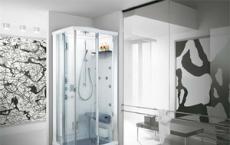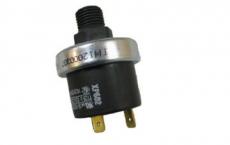Installation of house heat meters. General and individual counters. Method # 2 - individual measuring instruments
In our country, the law "On Energy Saving" was adopted. According to the document, all owners of housing are required to install in it the consumption of thermal energy. Controlling the flow of water, gas and electricity has long become commonplace. Many believed that heat is not amenable to any calculation, so the counters on it became a real novelty. How to put in an apartment is described in this article.
Benefit of installation
What do users think about heating meters in an apartment? The testimonies indicate that the benefits of installing the registration instruments are palpable.
The owner of housing must pay only for the heat received, not covering the costs of losses during transportation. For maximum savings, you must remove all sources that contribute to the loss of heat in the house: install window frames that are leak-tight, heat the room and conduct other activities. There are two options for installing the unit.
Installation of a common house meter
Many are interested in how to put meters for heating in an apartment.

It should be noted that people living in can solve the problem of accounting for heat consumption by resorting to installing not an individual, but a common household meter. This, it should be noted, is the cheapest option. After all, the cost of an accounting device is high, but it will be distributed among residents. The result will be quite acceptable.
Indications from the device the collector removes once a month. The owner of each apartment must pay according to the square of the living space. In this case, a clear condition is observed: if the heat supplier does not provide the consumer with the proper temperature in the room, then he undertakes to return the money contributed by the tenant.
How does the common house meter start?
The first stage of the event is a meeting of the tenants of the whole house. It discusses the key issues of the forthcoming installation. It also determines who will act as a collector, taking the testimony and issuing receipts for payment.
The decision of the meeting is fixed by the protocol, after which it is possible to apply to the company with a written statement on the consent to install the device.
The main priority of the common house aggregate is its cheapness. However, the economic side of its use may not satisfy users. There are many reasons. For example, insufficiently insulated apartments and entrances can lead to increased heat consumption.
Is there an exit? Do they install in an apartment?
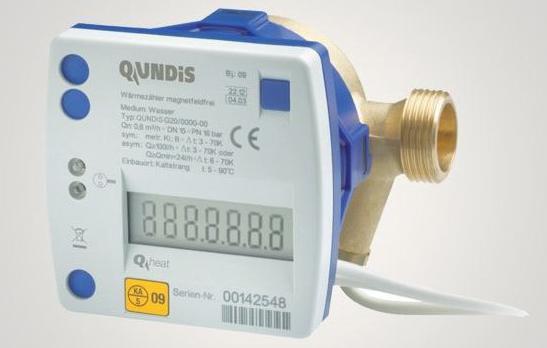
Often residents resort to the installation of individual counting devices. Such heat meters for heating for an apartment are much more expensive, but the level of efficiency they have higher.
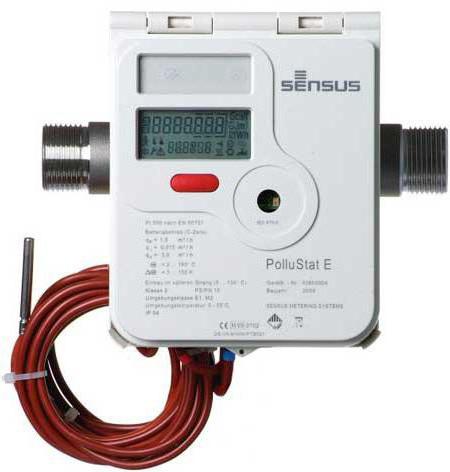
Technical restrictions on the installation of an individual counter
Before you put meters for heating in the apartment, you should familiarize yourself with a number of technical limitations. The heat meter of individual use is installed on the drain, which leads directly to the apartment. In multi-unit buildings of the old type, as a rule, heating pipes with vertical modification were provided for. This means that the apartment can have more than one riser. Each of them will have to install a counter, which will cost the owner quite expensive.
The solution to this problem is the installation of specially designed meters for heating appliances. But the installation of such a device in our country is not yet practiced, although in Europe this method has become widespread.
Manufacturers of aggregates offer a way out of their situation. In order not to put several meters, resort to the installation of distributors, which measure the flow of the coolant on the basis of the difference in temperatures on the surface of the radiator and air in the room.
Another way out of the situation is the installation of a common house device, which was described above.
In buildings in which wiring is made horizontally, the installation of meters to control the heat consumption is unlimited. Compact devices are mounted on a pipe that supplies heat to the room. In some cases, the installation is done on the pipeline.
Thermal counters operate with flowmeters of various modifications. Depending on the conditions of use, you can apply one of four options. Let's consider each separately.
Mechanical type
This is a counter with a unified design. It can be screwed, turbine or winged. The basis of the unit is the conversion of the translational motion of the coolant into the movement of the element for measurement.
This is the most affordable device in terms of cost. It can not be used if the role of the coolant is water with increased rigidity, or it contains particles of rust, scale or scales. They can clog the mechanical parts of the device. Therefore, before installing the units, special filter systems are installed. In addition, the mechanical configuration does not tolerate a sharp flow fluctuation.
Electromagnetic devices
Electromagnetic devices basically contain a current manifestation factor when the liquid passes through a magnetic field. Devices have a high enough metrological stability. They entered into extensive operation. Inaccuracies in the indications may be due to the presence of impurities in the water and poor quality of the wire connection during installation.
Vortex devices
Equipment is estimated vortices, which appear beyond the obstacle located on the path of the coolant. The design can be mounted both on pipelines with vertical and horizontal modifications. Devices exhibit sensitivity for the presence of air in the pipe, the level of welding quality and impurities contained in the water.
The deposits on the pipes do not adversely affect the operation of the device. Instruments are demanding for the size of straight sections in the pipeline before and after the flowmeter.
Units operating on ultrasound
They can measure the time for which the fluid has passed through the pipeline from the source to the reception of the signal. Devices are Doppler, frequency, time and correlation.
In any case, the work of the device is distinguished by impeccability. The device is measured in clean water without the presence of impurities or scale. Incorrect indications can occur if there are bubbles or scale in the coolant. This device is reliable and durable.
What should be attached to the counter?
Like any measuring device, the meter must have an appropriate certificate and a passport. The documents testify to the initial approbation of the unit, which was carried out at the plant. These indicators should be applied to the body of the device. They look like a stigma or a sticker. The timing of the control test depends on the model of the device. The average indicator of the event is once every four years.
Who conducts a preventive examination of the device?
The current check of the device is carried out after the expiration of the test interval.
To this end, the owner of housing must apply to a number of instances:
- local department of Rostest;
- a private organization that owns these powers;
- service center of the manufacturer.
Important information
In such a process as installing meters for heating in an apartment, you should choose a company that will provide installation at a professional level. Many companies guarantee further maintenance of the devices. Experts will be responsible for the planned inspection.

How to install and connect the device
How to put meters for heating in the apartment by all the rules? The owner himself does not have the right to install. Installation is carried out by special organizations that possess authorization accreditation for such services. Employees of companies stage by stage the following activities:
- the connection project is running;
- a document is agreed in the company that will install the units;
- there is installation of meters for heating in the apartment;
- after the end of work, the devices are sealed;
- equipment is being registered;
- devices are put into operation, and then they are transferred to the supervision organization.
How to choose a company to install a counter?
When choosing the company that will install the device, you should pay attention to a number of important points:
- the presence of a free engineer's departure to the facility, during which communications will be inspected;
- implementation of all stages of installation work;
- presence in the firm of special equipment and skilled workers;
- presence of the company's tolerances and certificates;
- information about the company in the Unified State Register of Legal Entities;
- guarantee for ongoing work;
- granting preferential services to a certain category of citizens;
- the possibility of payment by installments and the terms of its repayment;
- service provision.
Cost of meter installation
So how much are the heat meters in the apartment? The price for the measuring device itself, together with a regulation valve, a filter and a stop valve, is approximately 10,000 rubles or more, depending on the model.

However, to this amount, you must add the expense for installation. Therefore, it is necessary to pay not only heating meters in the apartment. The installation price will increase significantly and amount to about 20 000 rubles.
What to do with the testimony?
The readings from this unit are removed in exactly the same way as with an electric meter. Further the receipt in which the difference in indications multiplied by the current tariff is filled is filled.
The heating fee for the meter is paid in the branches of the Savings Bank. As a recipient, the company providing heat supply is indicated.
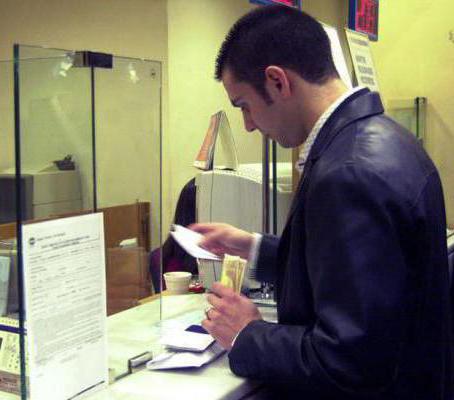
Conclusion
The heat meter will become a good assistant to the owner of the apartment or house. The main thing is to determine which common household or individual to install what device to use, and to assign the matter to professional workers.
About the counters for heating in the apartment, the reviews are very different. Many residents believe that the availability of individual devices contributes to saving monthly heat bill by 30-40%.
In unheated rooms, it is impossible to live in winter and nobody disputes with this. Hot radiators in the cold months - the communal benefit of modern life. However, bills regularly accrued by heating specialists are often overestimated. Only figuring out how to put meters on the heating in the apartment, the home owners have a chance not to pay extra.
To heat a house is expensive. But private owners have at least a choice of boiler equipment and fuel. Residents of high-rise buildings do not have a choice - central heating with tariffs appointed by the management company.
However, there is a tool to reduce the cost of heating the apartment - an individual heat meter.
In winter, the airing of an overheated room is the only thing that comes to mind to reduce the uncomfortable temperature in the room
When there is no quality heating. It happens that faults in the house heating network are forced to search alternative sources heat. Or the reason for the chilled room radiators is the intention of the housing administration to save on general heating costs.
Then the plumber fixes the valve of the stop valve, reducing the flow hot water in the heating system of the high-rise building. Residents freeze and warm themselves with electric heaters, increasing bills for electricity. But the cost of heating does not decrease from this.
When the heat is too much. Overheated air in the rooms is unpleasant, you have to open the window to lower the overall temperature level. And after all, outwardly simple methods are money spent on "street heating." They can be saved by setting the regulators on the heating batteries and the heat meter - on the heating circuit of the apartment.
Hidden components of payments for heating. From the boiler house the coolant enters the mains networks with one heating temperature, but at the input of the heating pipes into the houses its temperature is different, lower. Delivery of the coolant through the pipes is accompanied by heat loss due to poor insulation, this is understandable. But these heat losses are paid by the end user - apartment owners in high-rise buildings, not equipped with heat meters.
Monthly payments for someone else's living space
Each apartment house should be equipped with a heat meter - Article 13, paragraph 5 of Federal Law No. 261-FZ of 23.11.2009. The Management Company fulfills this condition and, based on the results of each month, removes the heat consumption for the high-rise building that it manages. Amount for thermal energy is simply divided between the apartments by their living space. Although this approach can not be justified.
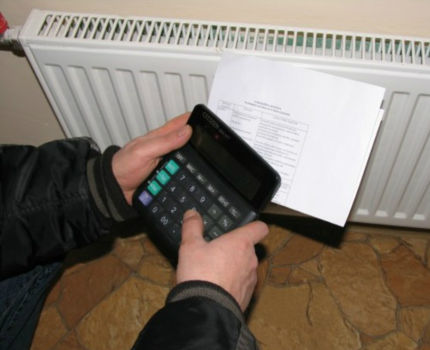
To pay for heating fees are good money. And half of them are spent in vain
Data on the living space, available in the Criminal Code, are based on the technical passport of each apartment. However, such data sheets often do not take into account the data on apartment re-planning, which increase the area of heating. There is no information on the increase in the points of connection of heating radiators.
Meanwhile, apartments with redevelopment and with an expanded number of heaters consume more heat than others. And since the general house heat energy consumption is divided by the passport housing, the residents of "ordinary" apartments pay for the heat consumed by the tenants of the "improved" apartments.
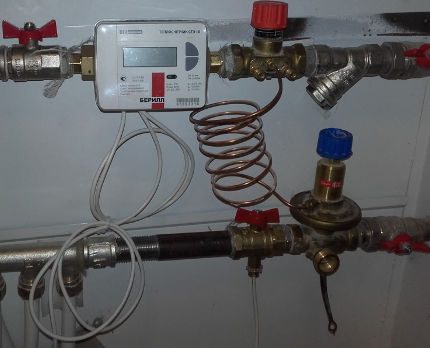
Individual heat meter on the contour of horizontal heating of the apartment
A simple way out of the situation of paying for someone else's heat - individual meters on the heating circuits of apartments. The savings in the cost of heat energy, the consumption of which is determined by the heat meter, will be more than 30% of the previous heating payments tied to the size of the living space (normative).
Types of distribution of apartment heating system
Apartments in high-rise buildings are equipped with either vertical or horizontal wiring heating system. In apartment buildings built before the beginning of the XXI century, heating systems were bred vertically.
Vertical heating system
The vertical contour of the thermal system is made by single-tube, less often two-tube. But always with a consistent run of coolant through the interstore levels - from the bottom up, then from top to bottom. Especially vertical distribution of heating is common in the Khrushchev.

The outline of a single-pipe thermal system covers several floors and apartments. Therefore, the heat meter can not be put on it
Heating with vertical wiring has serious disadvantages:
- uneven heat distribution. The heat carrier is pumped through a vertically oriented inter-floor circuit, which does not ensure uniform heating of the rooms at different levels. Those. in the apartments of the lower floors it will be noticeably warmer than in the rooms located closer to the roof of the high-rise building;
- difficult regulation of the degree of heating of the heating batteries. The need for each battery with bypass;
- problems with balancing the heating system. The balance of single-loop heating of vertical wiring is achieved by setting the shut-off valves and thermostats. But with the slightest change in pressure or temperature in the system, it is necessary to carry out the adjustment anew;
- complexity with an individual account of the heat consumption. Stoyakov in the vertical system of heating the rooms of the apartment more than one, so conventional heat meters will not work. They will need several - for each radiator, which is expensive. Although another heat metering tool is available for heating the vertical wiring - the heat spreader.
The construction of a scheme of a vertically oriented heating pipeline was cheaper than horizontal wiring - fewer pipes were required. Such savings in the era of mass model development of urban areas of Russia in the XX century was considered quite justified.
Horizontal distribution of heating in a high-rise building
With a horizontal wiring of the heating system, there is also a vertical feeder riser that distributes the heating medium along the floors. The pipe of the second riser serving as the return line is located in a vertical technical shaft next to the feeder riser.
From both distributive risers, horizontal pipes of two circuits are fed into the apartments - feed and return. The return line collects the cooled water, transporting it to a thermal station or a heating boiler.
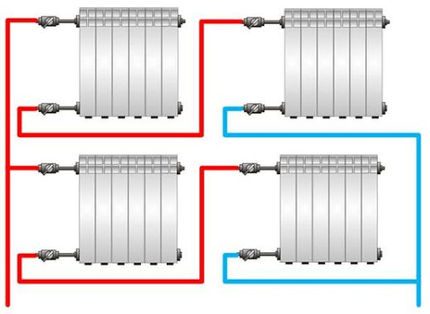
In a horizontal heating circuit, everything is simple - one coolant enters the apartment on one pipe, the other goes out.
Advantages of horizontal distribution of heating pipes include:
- the possibility of adjusting the temperature in each apartment, as well as in the entire highway (installation of mixing units is necessary);
- repair or prevention on a separate heating circuit without completely shutting down the heating system. The shut-off valve allows you to cover the outline of the apartment at any time;
- quick start of heating on all floors. For comparison, even in a well-balanced single-pipe vertical wiring system, delivery of the coolant to all radiators will take at least 30-50 seconds;
- installation of one heat meter on the contour of the apartment. With a horizontal distribution of heating, its equipment with a heat meter is a simple task.
The disadvantage of a horizontal heating circuit is its increased cost. The need for installation of a pipe-return in parallel with the supply pipe increases the price of apartment heating by 15-20%.
Features of heat meters
The group of individual heat metering devices is designed for operation in heating networks with a 15-20 mm diameter pipe channel and a volume of coolant in the range of 0.6-2.5 cubic meters per hour. Calculations of the consumed thermal energy heat meters and heat distributors perform independently, with the output of data on the electronic scoreboard.
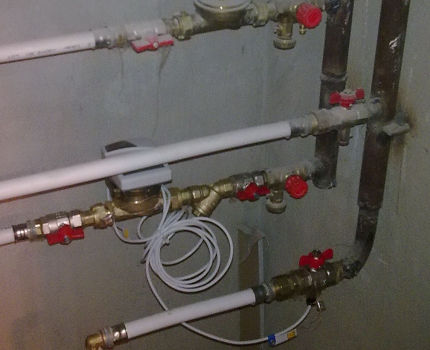
Horizontal distribution of heating pipes allows you to set the heat meter secretly, in a communication niche or mine
The computational module of the device determines the amount of heat consumption for a specified period of time (hour, day or month), storing and accumulating this information in the device memory for 12-36 months. The most convenient is the installation of a non-volatile counter for heating (ie with an additional power source - a battery).
Depending on the model of the heat meter, its measurement values are displayed as kilowatts per hour, megawatts per hour, gigajoules or gigacalorie. For managers and other utility companies, a test for heat in Gcal is required. To recalculate in gigacalory it is necessary to apply the appropriate transfer formula. For example, for kilowatts per hour - multiply the value by a factor of 0.0008598.
Types and characteristics of residential heat meters
Each meter is a complex of several devices. Its kit can include temperature sensors, calculators of the amount of heat consumed, as well as converters for pressure, flow and heat carrier resistance. The exact configuration of the heat meter is set by the manufacturer for a specific model.
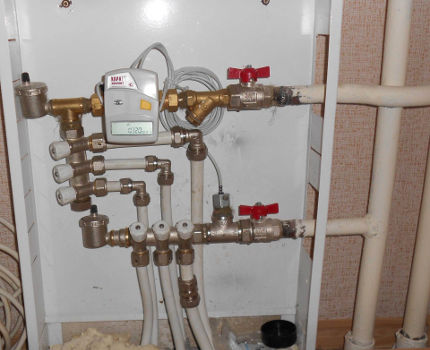
It is convenient to install the heat meter at the final stage of installation of the apartment heating system
Depending on the principle of accounting for consumed thermal energy, heat meters are equipped with ultrasonic or mechanical (tachometric) flowmeter. Also, models of instruments with flowmeters of other types (for example, vortex or electromagnetic) are produced, but they are not widely distributed. Heat meters are designed to collect information on the heat consumption only on the horizontal wiring of the heating circuit.
A separate group of heat meters are calculators and heat distributors, which do not require tapping into the heating circuit. These devices are used to calculate the heat costs of heating radiators for any heating circuit diagrams.
Mechanical thermal counter
The simplest type of construction, so the cheapest (about 9000-10000 rub.) - a device with two-wire temperature sensors, a water meter and an electronic calculator unit. The main working element of the meter is a part (impeller, turbine or screw) rotating when passing through the coolant device. The number of rotations determines the volume of the heat carrier passed through the counter.
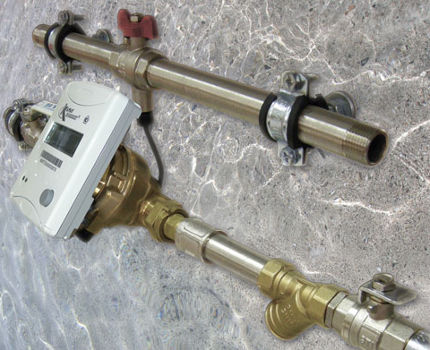
The order of installation of the heat meter is externally uncomplicated, but its performance depends on the efficiency of the device
Contact thermometers are integrated in the supply pipes and return flow of the heating circuit of the apartment. The first thermometer is placed in the counter, in a special socket. The second one is installed on the return pipeline, in a ball valve of special design (with a socket) or in a tee equipped with a thermowell.
The advantages of mechanical heat meters:
- the cost of about 8000 rubles;
- the design is simple and reliable;
- no external power required;
Attracts sufficiently correct stability of the indicators and the feasibility of mounting in a horizontal or vertical position.
Minuses of thermal counters of mechanical type:
- the period of guaranteed work is not more than 4-5 years. Every 4 years verification is required;
- high wear of rotating parts. However, all mechanical counters are repaired for little money;
- the rotating element helps increase the pressure in the heating circuit;
- susceptibility to water hammering;
- high need for a coincidence of the actual flow of the heating medium in the heating system to the nominal flow established by the manufacturer.
It is mandatory to incorporate a magnetic filter into the circuit coarse cleaning before the mechanical thermal counter. The device is extremely sensitive to the content of mechanical suspensions in the volume of the coolant!
Ultrasonic heat meter
The coolant flow rate is determined by means of an ultrasonic signal emitted by the radiator and received by the receiver. Both elements of the thermal ultrasonic meter are mounted on a horizontal heating pipe, a certain distance is established between them.
The signal from the radiator follows the flow of the heat carrier and reaches the receiver after a period of time, depending on the velocity of the coolant in the heating circuit. Based on the time data, the coolant flow rate is set.

There are no rotating elements in it. Therefore the service life of the ultrasonic heat meter is longer, and the heat data is accurate
There are more than 10 variants of ultrasonic flowmeters - frequency, Doppler, correlation, etc. In addition to the main tasks, the ultrasonic heat meter can have the function of regulating the flow of the coolant.
Pros of ultrasonic heat meters for apartments:
- low price in the basic configuration - from 8000 rubles. (domestic models);
- data on heat consumption are called up on the LCD screen by pressing one button, which is convenient;
- operation of the device does not cause an increase in hydraulic pressure in the heating system;
To weighty pluses carry long term service - more than 10 years (verification is necessary every 4 years) and power from the built-in battery.
Minuses of ultrasonic heat meters:
- sensitive to the composition of the coolant. If the air bubbles and mud particles (scale, scale, etc.) are contained in it, the readings of the device will be incorrect, and in the direction of increasing heat consumption.
For ultrasonic flowmeters there is one installation rule - the pipeline section in front of the device and after it must be straight (the required total length of a straight segment is more than a meter). Then the meter will provide the correct data on the heat consumption.
Calculator and heat distributor
These devices perform measurements of the relative costs of thermal energy. In their design - a heat adapter and two temperature sensors. Every three minutes the sensors measure the temperatures on the surface of the radiator and in the room atmosphere, determining the difference. The collected information on the heat consumption is summarized and displayed on the device screen.
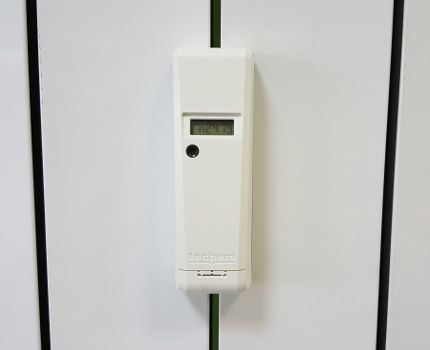
Such a heat meter does not need to be hidden - it fits perfectly in the modern interior of the room
Heat calculators are programmed to operate on a certain type of radiator at the time of installation on it. All the necessary coefficients and power parameters of the radiator are entered into the memory of the meter, which allows it to display the data on the heat consumption in kilowatt-hours.
The figures indicated by the heat distributors are displayed in conventional units. To translate them into kilowatt-hour, multiply the value of the readings by the rating of the radiator and the coefficient corresponding to the type of the radiator. Figures of the coefficient are provided by the meter manufacturer based on the results of laboratory tests.
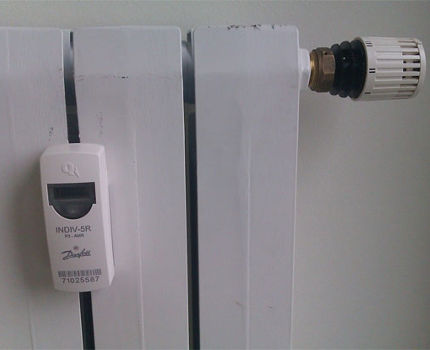
The heat distributor is similar to a heat calculator. They are distinguished by the inability of the distributor to regard heat as kilowatts per hour. In general, the heat distributor is simpler than the calculator
Calculators and heat distributors are placed to conduct heat energy measurements on a single radiator. Those. in an apartment where heating is accounted for by such appliances, there should be as many meters as there are heating radiators. Both types of meters are effective regardless of the apartment heating scheme and the operating characteristics of the coolant used in the heating circuit.
The advantages of distributors and calculators of heat:
- the cost of the order of 2000-2500 rubles. Those. their installation is advantageous in small apartments equipped with five radiators or less (but more than 2);
- long service life without verification - 10 years;
- simple and quick installation on or near the radiator housing;
- transmission of data from several heat meters via a radio channel to a single controller, summing them (the availability of a radio module depends on the model of the device);
A convincing argument in favor of installing such devices is the complete independence of the measurement results from the quality of the coolant.
Cons of apartment calculators and heat spreaders:
- the relative error of measurements is up to 7-12% (the greatest error is inherent in heat spreaders), which is higher than for "in-line" heat meters;
- data on energy consumption are correct, if calculated from the results of measurements of several devices within the boundaries of the apartment. One calculator is not able to correctly determine the heat consumption by the atmosphere from one radiator. Consolidated data for several devices are needed;
- effective work only on factory models of radiators of heating. Those. any modifications of the factory equipment of the radiator when measuring the heat by such heat meters are unacceptable.
Mounting kit for installing a calculator or a heat distributor is selected by the type of radiator on the body of which the meter will be installed. Hand-made ways to install a meter will degrade the quality of data collection. If there is no specialized mounting kit, it is more rational to fix the device next to the battery that is served by it.
The procedure for the lawful installation of a heat meter
The sequence of actions aimed at installing an individual heat meter in the apartment is as follows:
- written request to the house management organization for the permission to install the heat meter. To the letter it is necessary to attach copies of documents on the right of ownership to the living space, technical passport of the apartment;
- obtaining technical conditions for the installation of a heat meter from a heat energy supplier (usually a management company);
- preparation of a project for individual heat metering and installation technical documentation. Implemented by an organization that has the legal right to provide project services;
- reconciliation project documentation with a heat supply enterprise.
Acquire a heat meter before obtaining an agreed project on thermal energy should not be, because may be refused for various reasons. Having all the documentation for the project, it remains to choose a thermal meter - ultrasonic, mechanical or external installation (for example, heat calculator).
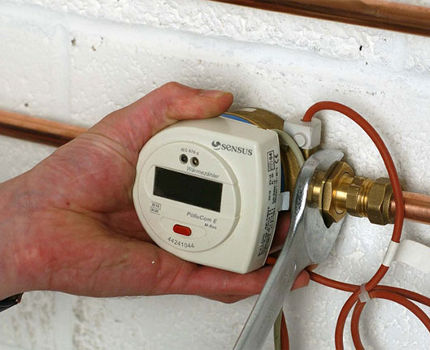
The device, which is obliged to save up to 50% of the cost of heating - it should install a pro. And with a guarantee
On the purchased model, you need to receive from the seller checks (commodity and cash), instructions, warranty card and a copy of the current certificate of quality.
The company that installs the heat meter must have a license for this type of work. Before selecting a contractor, it is necessary to evaluate the data on the candidates (USRLE, certificates, SRO permits), the professionalism of installers (special equipment, the list of installation works, the availability of the installation kit), the guarantees of the work performed.
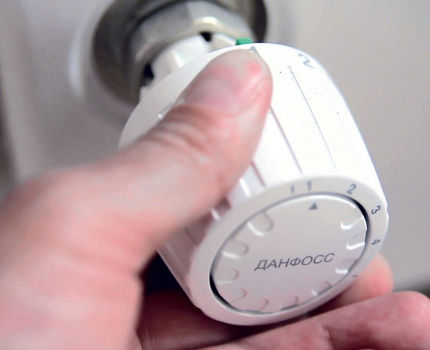
The quality of the thermostat installed on the radiator is important. It will allow you to manage the heating of the battery, and hence the cost of heat
Please note that in addition to heat counter additional devices and devices will be needed: bypass, radiator thermostats, pipe filters, tees, etc. The sealing of the heat meter or the heat distributor after installation works is mandatory. Seals are put by representatives of the heat supply enterprise.
When the installation is impossible or unprofitable
In the installation of an individual heat meter, the management company will be refused if there is no house heat meter in a multi-storey building. To calculate the coefficient of ODN, you need to know the heat consumption of the whole house.

Complex ITP allows you to fine-tune the heating of the entire high-rise building. So - payments for heating will decrease.
Payments for the heat meter in the following situations will be higher than without it:
- the input of the heat main to the multi-storey building is made according to an outdated scheme - through the elevator;
- the apartment is at the end of the house, on the last or first floors;
- there are slots in the window frames, in the front door box;
- balcony (balcony) is not glazed;
- purged entry room (broken windows, ajar door), etc.
Note that in order to minimize the cost of heat energy, it is not enough to establish a house-building and apartment meter. It is necessary to modernize the heating system of the building - to replace the elevator unit at the AITP or AUU. Only in such a power system of high-rise buildings it is possible to achieve comfort in apartments with minimum payments for heating.
Video about individual heat meters
Installation of a heat meter is a requirement of the legislation of the Russian Federation. But this norm does not apply to apartments in high-rise buildings. The reasons for which there may be problems with individual heat meters are discussed in this video:
The Petersburger installed heat meters in his apartment in 2013 and was convinced of the 30% overpayment for heating. But ZhSK-3 does not hurry to compensate its expenses. Watch the video:
Legislation requires equipping the heating network in a high-rise building with a house meter, but only common (for the whole house). And individual house counters benefit from managers of multi-apartment households in the only case - if the house is new or reconstructed (heat-insulated) according to modern standards.
In Russia, the law "On Energy Saving" was adopted. The document obliges all owners to install meters in their homes. To monitor the consumption of water, gas and electricity has long been a habit among most landlords. Many mistakenly considered heat to be an unrecordable factor, so heat meters for them became a real novelty. How to install the device that is mandatory for all? Let's understand.
Variants of installation of metering devices
The benefit of installing meters is obvious. The owner of the housing will pay only for the heat received, without forking over the payment of losses when transporting it. To save the maximum it is necessary to remove all sources of possible heat loss in the house: install airtight window frames, insulate the room, etc. There are two options for setting the counter.
Method # 1 - house counters
Residents of high-rise buildings can solve the problem of accounting for heat by installing a common house metering device. By the way, these are the most inexpensive option. After all, the price of a heat meter, which is not cheap, and its installation will be "scattered" on the owners of several apartments. The amount received as a result will be quite acceptable. The readings of such a device are taken once a month. Payments are distributed to each apartment in accordance with its area. At the same time, if the service provider does not fulfill its part of the contract in good faith and does not ensure the agreed temperature in the house, it will be obliged to return the paid money to the residents.
It should begin with the holding of a general meeting of apartment owners. It should discuss all the nuances of the upcoming installation and determine who will take the meter readings, and write out receipts for payment. The decision of the meeting must be fixed in the protocol, after which it is possible to contact the management company with a written application for connecting the device.
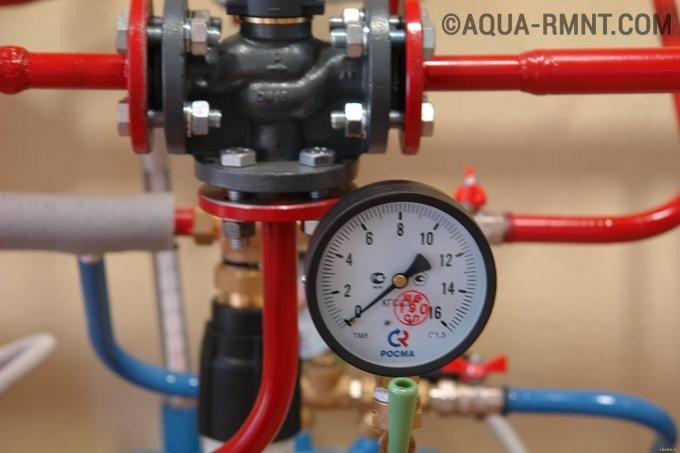
The most inexpensive method of accounting for heat is a house count. However, for a number of reasons, the economic effect of it can not wait
Method # 2 - individual measuring instruments
The main advantage of a house-building device is its cheapness. However, the economic effect of its use may be much lower than expected. And there are many reasons for this. For example, insecure entrances or apartments neighbors, resulting in heat loss are prohibitive. Therefore, many choose individual meters for heating, which are installed directly in the apartment. This is a more expensive, but very effective option.
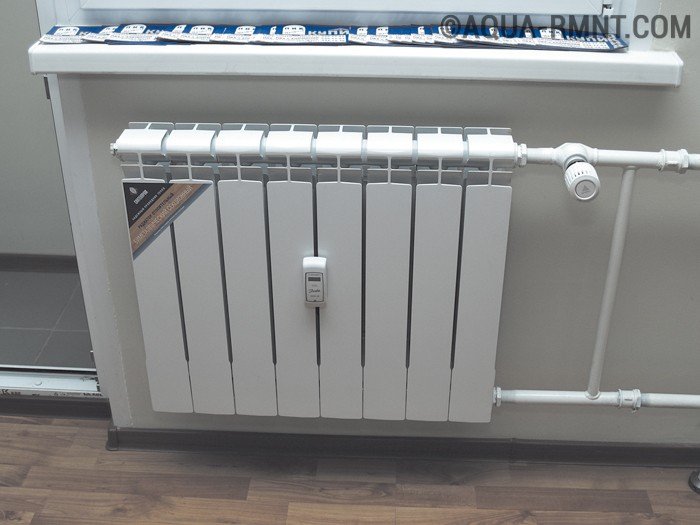
Distributors are installed on each radiator in the apartment. Within a month they fix the temperature of the batteries, keeping track of the slightest drops. Based on this information, the heat fee is calculated
Before planning the installation of an individual accounting device, you should familiarize yourself with some technical limitations. The heat meter is mounted on the riser leading to the apartment. In old multi-apartment buildings, vertical piping of heating pipes was most often performed. This means that the apartment can have several risers, each of which must be installed device, which is extremely disadvantageous. The solution to the problem could be the installation of special meters for heating batteries, but such equipment is not used in our country, although in European countries it is a common practice.
Manufacturers of meters offer to install in houses with vertical wiring so-called distributors, which measure the flow of coolant based on the difference in temperature on the surface of the battery and in the air of the room. Another solution to the problem is a house-keeping meter. In buildings with horizontal wiring installation in the apartment of any heating meters is not complicated. Compact models of devices are mounted on a pipe supplying coolant to a room or, in some cases, to a return pipeline.
Classification of instruments
Heat meters work with flowmeters of different types. Depending on the operating conditions, you can choose from four options.
Mechanical devices
Relate to the most simple counters. Can be screw, turbine or vane. The principle of operation of the device is based on the transformation of the translational motion of the coolant into the movement of the measuring element. The most affordable equipment. Can not be used if hard water is selected as the coolant, or if rust particles, scale or scales are present. They clog the mechanical parts of the device, so it is recommended to install special filters before it. Besides mechanical devices poorly tolerate sharp fluctuations in flow.
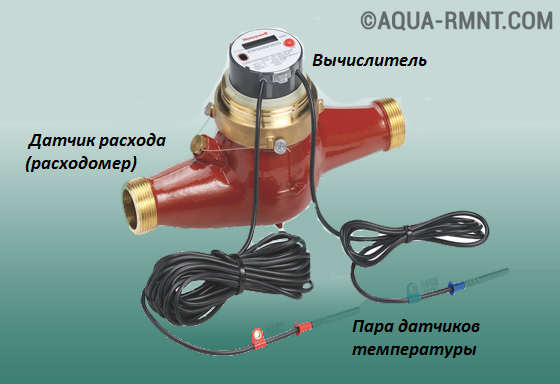
Mechanical heat meters are considered to be the simplest measuring instruments. However, they are very sensitive to the quality of the coolant, they quickly clog and go out of order
Electromagnetic equipment
Electromagnetic counters for heating in an apartment in their work use the factor of the appearance of an electric current when passing a liquid in a magnetic field. The instruments have a sufficiently high metrological stability and are successfully operated. The inaccuracy of the devices increases when impurities appear in the water and poor connection of the wires during installation.
Vortex counters
The equipment estimates the vortices formed behind the obstacle located in the coolant path. Can be installed on both vertical and horizontal pipelines. Instruments are sensitive to the presence of air in the system, the quality of welding and impurities in the water. For their functioning, it is necessary to install a magnetic-mesh filter. Deposits in the pipes do not interfere with their operation. Devices are demanding on the dimensions of the straight sections of the pipeline in front of the flow meter and beyond it.
Ultrasonic devices
Measure the time that the fluid passes from the source to the signal receiver. Devices are divided into Doppler, frequency, time and correlation. In any case, the equipment works flawlessly, measuring in a homogeneous clean liquid without impurities of sediment or scale. Distortions occur when air bubbles, scale or scale appear in the coolant. The most durable and reliable option.
Like any measuring device, the meter must have a certificate and a passport. The documents must include the information on the primary verification carried out by the manufacturer. The same information should be applied to the meter body in the form of a special stamp or sticker. During operation, the devices must also be subjected to regular verification. The timing of its implementation depends on the model of the device. On average, the event is held every four years.
One way to reduce the cost of utility bills - the installation of meters. Devices recording the consumption of gas, water and light, are familiar to everyone, but the device for recording heat is not in every multi-storey building. Its presence allows you to pay only for the amount of energy that was spent on heating the housing, excluding losses during transportation and other costs included in the weighted average tariff. Let's consider, in what versions modern meters for heating in an apartment are let out, and also we will find out features of their installation.
What is the purpose of heat meters for heating in a multi-apartment building? The purpose of the device is to accurately measure the amount of heat consumed. The basis of the calculation is the recorded difference in the temperatures of the coolant (water) in the feeder and return piping centralized system heating.
Without the meter, the calculation is carried out according to the general standards. Their value is equal to the calculated (theoretical) amount of energy, measured in gigacalories, which is required for heating 1 m 2 of housing during the month. The figure is adjusted depending on the average monthly air temperature in the street and the type of structure. In any case, the standard puts heat losses during transportation, which can be 20-30%.
Most experts believe that the general tariffs are significantly overestimated compared to real consumption. Moreover, utilities do not always perform their duties properly, and often tenants have to pay for cold batteries. In addition, the state is trying to stimulate the installation of heat meters, charging an additional "penalty" factor to the normative indicator. Therefore, heat meters for heating - an effective method of saving costs for housing and communal services. Reviews show that the amount in payments becomes 20-25% less.
Important: In order to fully benefit from the use of the meter, all sources of heat loss should be eliminated before installing it: take care of the tightness of the windows and insulate the walls.
Types of counters
Depending on the type of flowmeter, heat meters for heating for an apartment are divided into:
- mechanical;
- electromagnetic;
- vortical;
- ultrasound.
Mechanical
The mechanical counter is the simplest version of the meter. The principle of its operation is based on the transformation of the coolant motion into the rotation of the measuring part. The device can be turbine, screw or vane.
The main advantage of such a device, as a mechanical counter for heating in an apartment, is the price. It is in the range of 6000-10000 rub. Its shortcomings include:
- susceptibility to the quality of the coolant - the parts of the device quickly fail with increased water hardness, the presence of rust and other contaminants in it;
- incorrect work with sudden changes in the fluid pressure in the supply system;
- short service life - 2-4 years.
Electromagnetic
Electromagnetic counters gradually displace mechanical ones. Their work is based on electromagnetic induction - the current appears only when a liquid (coolant) passes through a magnetic field.
Benefits:
- safety - the current does not come into contact with water directly;
- accuracy;
- affordable price - about 17000 rub.

Disadvantages:
- difficulties with the connection - it is important to connect all the wires correctly and reliably;
- malfunctions in work with a poor quality of the coolant - the reliability of measurements is reduced.
Vortex
Vortex heating meters take into account the amount of thermal energy based on the number of turbulent eddies formed behind the obstacle installed on the path of the circulating fluid. The average price is 15,000 rubles.
Benefits:
- accuracy;
- possibility to install on vertical and horizontal pipelines;
- immunity to deposits on the walls of pipes and mineral salts in water.
Disadvantages:
- deterioration of the quality of work in the presence of air bubbles and coarse impurities in water;
- sensitivity to temperature changes and welding operations in the system;
- the need for straight pipe sections of a certain length in front of the meter and after it.
Ultrasound
Models ultrasonic counters for heating in an apartment are considered the most reliable, durable (the lifetime is practically unlimited) and accurate. The operation of the instrument is based on recording the time for which ultrasound comes from the source to the receiver, overcoming the flow of liquid. Information on the signal delay time is used to determine the flow rate of the liquid in the pipeline. Devices are Doppler, time, correlation and frequency.
The downside of the ultrasonic device is the sensitivity to the purity of water and the presence of oxygen in it. Impurities, air bubbles and deposits on the walls lead to a distortion of the indicators. How much does a heating meter cost in an apartment that uses ultrasound? From 15000 to 48000 rubles.
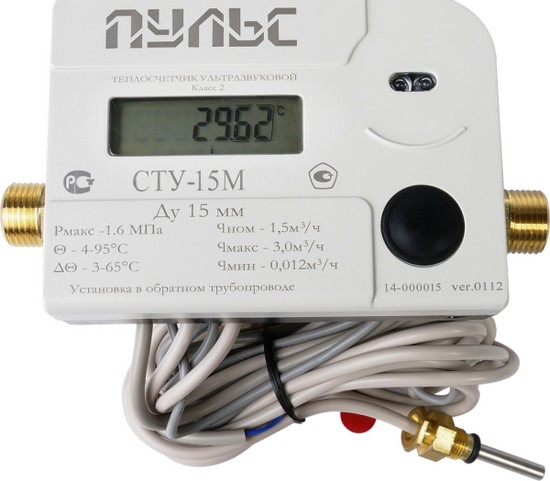
Tip: The service life and accuracy of the recorded data of any heat meter can be increased by installing a magnetic-mesh filter on the heating system inlet.
General and individual counters
The thermal counter can be set to:
- central collector high-rise building - the heat received by all apartments connected to the riser is taken into account;
- separate nozzles - the resource arriving in a concrete apartment is registered.
Ultrasonic devices are used individually. Mechanical, electromagnetic and vortex devices can be installed on the whole house, and on a separate apartment.
Commonwealth
The common house heat meter joins the main riser, which is located in the basement and provides heat to all apartments. How to calculate the heating in the apartment by the meter? Accounting for costs is as follows:
- At a certain number of the month, the current readings of the heat meter are taken.
- There is a difference between them and the previous number of gigacalories.
- The received number is multiplied by the current tariff, appointed by the state.
- The amount is divided between the apartments in proportion to their area.
As a result, tenants pay for the heat that has flowed into their apartments, and also went to the heating of staircases, basement, attic and so on. Common house counters are expensive. The price of the device itself can reach 150,000 rubles, in addition, the cost of its installation and maintenance. All costs are divided equally between the apartments. In many cases tenants are allowed to pay the amount in installments for some time.
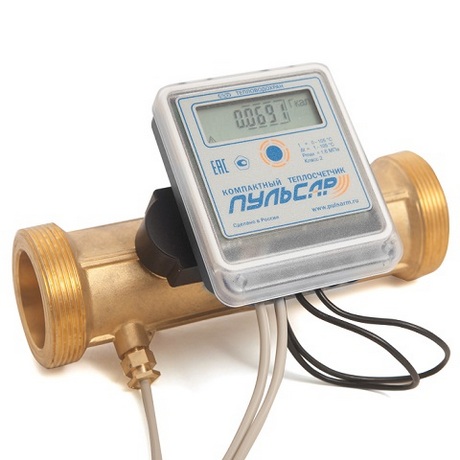
Individual
With all their advantages, house heating counters have some disadvantages:
- to install the device you need the consent of all tenants, which sometimes can not be obtained;
- the device does not take into account the uneven distribution of heat - in insulated apartments that are in the middle of the house, the temperature will be higher than in the corner and "purged", but the payment is the same for all (including area);
- even if there are thermostats on batteries, they do not need to be screwed on for the sake of economy, since this does not affect the amount of payment for heating.
Solve the listed problems will help counters for heating batteries in the apartment. The costs for the acquisition, installation and maintenance of the appliance lie entirely on the shoulders of the owner of the dwelling, but he has the opportunity to clearly control the receipt of heat independently. The device is mounted on an individual riser, which supplies the coolant to the apartment.
Before making a decision, you should find out if you can put a heating meter in the apartment? The fact is that in most old houses the wiring from the riser goes vertically, that is, each radiator has its own pipe. It turns out that all of them need to put appliances. But it is very expensive, in addition, it is practically impossible to reconcile the testimony of many counters. The way out is to install valves on all radiators. These devices determine the temperature difference on the surface of the battery and in the room.
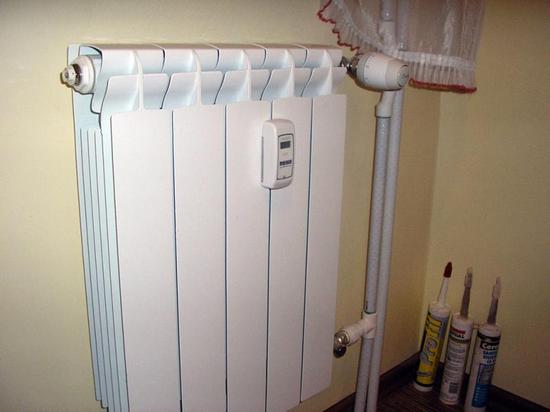
However, not all operating offices accept such indications to account for the heat received and to calculate the cost of services. With horizontal wiring of the heating system, you can set up any kind of meter.
Basic stages of installation
When installing a house heating meter The first stage is the holding of a meeting of tenants and the adoption of an appropriate decision, which must necessarily be fixed by a protocol. Immediately it is necessary to appoint a person who will be responsible for the installation process, the subsequent monitoring of indicators and the calculation of payments. If it is a question of an individual apartment counter, then the owner takes all decisions himself.
In both cases, the following procedure includes the following steps:
- Contacting the organization that installs the meters, with the application and the protocol (for common house devices) or with one application (for individual meters).
- Drawing up a project, defining the technical features of the building.
- Harmonization of all documentation with an organization that provides a centralized supply of heat.
- Selection and purchase of the device. It is important that the device has a passport, certificate, stamp (seal) and a sticker, confirming the fact of its verification by the manufacturer.
- Direct installation of the meter, carried out by professionals.
- Registration of the device in an organization that has supervisory functions in the field of heating apartment buildings.
- Putting the meter into operation.
Note: Once in 4-6 years, the heat meter should be checked. To do this, you need to contact the service company.
Installation of a counter for heating - effective method control of resource consumption. The device allows you to pay only for the amount of heat that has flowed into the house or apartment. This protects the owners of housing from dishonesty of public services and extra costs, which are laid in the regulatory tariff. If you combine the installation of an individual meter with the equipping of radiators with thermostats, you can save a lot on utility bills.
Counters for heating in the apartment reviews
"We have been using the heating meter for about a year now. If you just talk about the merits, then the savings are significant. The area of 46 square meters, for heating used to be within 7000 rubles, after installation, the maximum was paid - 4600 rubles.
Chose a cheap option: a heat meter Sensonik II, a German manufacturer, good quality, the installation cost about 9000 rubles. During the use of the heat meter, the cost of acquiring it has already paid off. We do not regret at all that we have established, family budget saves not one thousand a month. "
Alain, Kirov
"I wanted to put a counter on the heat in the apartment. I chose the most inexpensive apartment mechanical counter Pollucom E SENSUS. The cost of such a device from 3000 hryvnia. Slovak assembly, quite acceptable quality.
The main "minus" refers to all counters in which the mechanical flow sensor is highly sensitive to the quality of the liquid in the batteries. In old systems, counters, as I was told, do not last long, quickly fail. "
Anton, Kharkov
Residents of apartment buildings have many claims to heat suppliers. If we reduce all complaints to a common denominator, we will find out that people are not satisfied with the lack of transparency in the formation of payment. The amounts on the accounts are impressive, but for what the consumer paid specifically, how much heat really got - a mystery with seven seals. The problem is solved very easily, for this purpose it is enough to install heating meters. The device allows you to determine how much heat was actually received, and calculate the fair amount of payment.
The principle of operation of different types of heating meters
Flowmeters, which are equipped with heat measuring devices, can work on different principles. Depending on the type of flowmeter, four types of counters are distinguished:
The heating meter is a device, through which you will pay an honest price for the heat received
- Mechanical. The principle of operation of these heat meters is based on the transformation of water movement in the system into sensor motion. Depending on the design, screw, turbine and vane counters are distinguished. Mechanical equipment is the cheapest, but it is not very precise and has limitations in application (for example, hard or polluted water).
- Electromagnetic. Devices fix the appearance of a current when the coolant passes a magnetic field. The equipment is quite accurate, but also responds to water quality.
- Vortex. These counters record the presence of vortices that appear after the passage of water obstacles. The quality of the coolant, the presence of air in the system are very important.
- Ultrasound. Devices can be frequency, Doppler, correlation, time. All ultrasonic equipment is quite expensive, but reliable, accurate and durable. There are also limitations in the application, they are usually indicated in the accompanying documentation for each model.
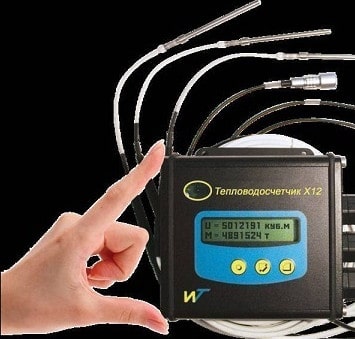
Ultrasonic heat meters are accurate, reliable, durable
Connection and verification of the heat meter
About the benefits: how much does it cost to install a heat meter
To understand whether it is advantageous to install a counter, you need to calculate the cost of the device itself and the associated costs. The price of the device depends on the type of flowmeter. The final cost includes the device itself, accessories, installation costs. Installation can only be carried out by a company that has all the necessary permits for the provision of such services. Having finished installation of the counter for heating, employees of the company seal it.
The device needs regular verification every 4 years. All services are paid. As a result, the cost of installing heat measuring equipment is significantly increased, but costs are paid off by saving on paying utility bills.
Who to contact for verification of measuring equipment
The new counters have already been checked, as evidenced by the records on them. This information is duplicated in the accompanying documentation. Initial verification is carried out at the factory. After expiration of the interim period, the owner of the heat meter can contact the following organizations:
- In the firm that installed the meter for heating. Often, the contract for subsequent maintenance is concluded immediately, and the company's specialists take care of all the verification tasks.
- To the local branch of the state institution, which is engaged in certification and verification of measuring equipment.
- To the service center of the manufacturer of the device.
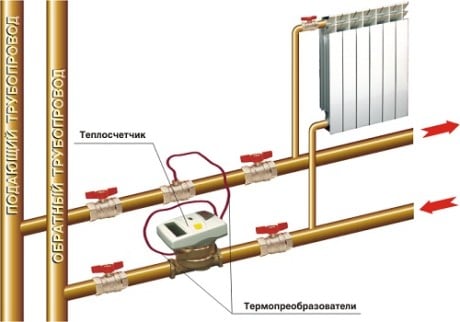
Which device to deliver - general or individual
Virtually all who installed heat-measuring equipment, argue that this is a profitable investment of funds. Disagreements arise only when discussing the installation methods (general or individual) and the types of the device itself. Whichever installation option you choose, keep in mind that the sums of accounts depend not only on the temperature of the batteries, but also on the degree of thermal insulation. To minimize costs, it is desirable to achieve tightness of the window frames and, if possible, to insulate the walls.
The common house is cheaper
Such a device is installed on the entrance. Installation and maintenance of the device is relatively cheap, as the costs are distributed among all tenants. Once a month they take the meter reading. The amounts of payments are calculated for each apartment, depending on its area. Another advantage in installing such a heating meter is the ability to claim compensation from a service provider if it does not fulfill its obligations to the fullest. If the house does not maintain the appropriate temperature, he is obliged to return the money to the residents.
To put a house heating meter, you need to hold a meeting of all apartment owners. On the agenda are the issue of installing the device, discussing who to entrust the installation. If the decision on the main issue is positive, then you must also appoint an authorized person who will take the testimony and calculate the amounts of payments. The entire course of discussion is recorded in the protocol. To install the measuring equipment, prepare a written application to the management company.
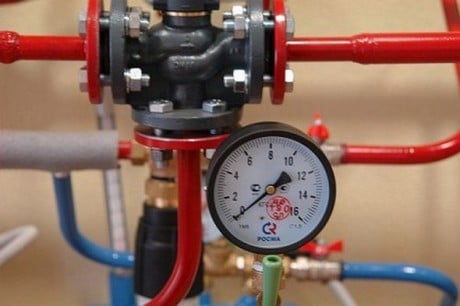
So it looks like a house heat meter for heating
Individual - more precisely
Often, there are disagreements between neighbors who have established house-building counters regarding the amounts of payment for heat supply services. Sometimes heat loss is so great that they "steal" all the benefits from the device. It happens, if the whole entrance is generally poorly insulated, windows are broken, the frames in the apartments are not sealed. In this case it is much more profitable to install heating meters in the apartment. It will cost more, but the owner of the apartment will be sure that he pays only for the amount of heat energy that he consumes.
The readings of the heat meter are taken in the same way as from the electricity meter. When filling out the receipt, you need to subtract old indications from new ones, multiply the difference by the tariff and pay to the account of the heat supply organization.
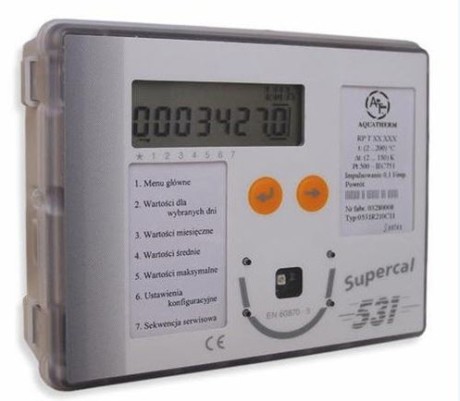
Heat calculator SUPERCAL 531 produced by Aquatherm
Technical limitations: when the counter is not profitable
The measuring device is mounted on the riser, which leads to the apartment. In the projects of multi-unit buildings of old construction, the distribution of heating pipes is usually vertical, which implies the presence of several risers. Installation of several meters is economically unprofitable for apartment owners. In this case it is possible to put either counters on heating batteries (which is still rarely practiced in our country) or special distributors. The second option is quite feasible. The instrument will measure the temperature difference between the battery and air. Based on his testimony, the amount of payment for heat is calculated.
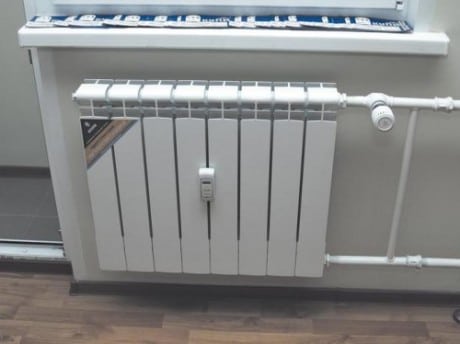
Appearance of the distributor. These devices are installed on all batteries in the apartment
The growth of tariffs for heating bothers everyone. It is possible and necessary to fight for honest relations between suppliers and consumers of heat. Installation of measuring equipment is the most effective method, forcing heat supply organizations to fulfill their obligations to consumers of services. Consider heat and pay only for what you use.

